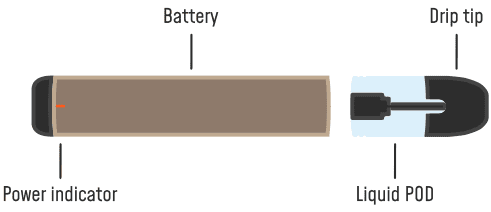Health

The use of electronic delivery devices has grown since 2014 and is projected to steadily increase. Studies show that these devices are used more than traditional cigarettes among US middle and high school students. The flavors, ease of concealment, and high-tech nature of these devices are the main appeal for youth.
What are electronic nicotine delivery devices?
Vapes, dab pens, and electronic cigarettes (e-cigarettes or e-cigs) are some of the many terms used to describe electronic nicotine delivery systems (ENDS). ENDS is a catchall phrase for the different electronic cigarettes used to vape. They are battery powered devices that heat a liquid into an aerosol that the user inhales. The liquid usually has flavorings, nicotine, and other chemical additives.
How do you identify devices? Where do students hide them?
School administrators, teachers, and staff have likely seen electronic cigarettes in their schools without recognizing them. They are difficult to identify because there are so many different sizes, shapes, and brands of electronic cigarettes, making them easy to overlook and hide from adults.
Electronic cigarettes may resemble a USB drive, highlighter, pen, marker, credit card, computer mouse, or even a smart watch. The latest device is a hoodie that uses the strings of the hood as the delivery method.
One easy way to check if the suspected items are actually electronic cigarettes is to look for holes on each end of the device. Most vaping devices have holes on both ends.
What are the signs that kids are vaping?
- Sweet smell. The most popular flavors are sweet, so you may notice an unusually sweet smell in classrooms, bathrooms, etc.
- Changes in thirst and taste. Vaping makes users’ mouths dry. Students drinking more water than usual may be a sign that they’re vaping.
- Nosebleeds. Not only does the mouth get dry when vaping but also the inside of the nose as the vapor is exhaled through the nostrils. This can result in nosebleeds.
- Unexplained cough, throat clearing, or mouth sores. Researchers have linked vaping to mouth wounds that won’t heal and a smoker’s cough.
- Increased secrecy. You may notice that students are hiding something.
- Mood swings, agitation, or changes to academic, artistic, or athletic performance. Nicotine addiction can cause changes in behavior.
- Shortness of breath or wheezing. Students who don’t have asthma may start wheezing.
How can schools respond to vaping?
School administrators, teachers, and staff can effectively fight the use of electronic nicotine devices in their schools by educating themselves.
Electronic cigarette trends change frequently. All school personnel need training on electronic cigarette use, the dangers of vaping, and how to spot electronic cigarettes in classrooms and other areas in the school, such as in bathrooms.
Other actions:
- Reviewing, updating, and enforcing the school policy on tobacco and drug use, including vaping.
- Installing smoke detectors in bathrooms.
- Including students in an anti-vaping campaign through peer education or poster contests.
- Partnering with Alabama Cooperative Extension System’s Nutrition, Diet, and Health team to implement educational classes for students about the dangers of vaping. Please contact your county Extension office to request a program.
Parts of a Pod System

Battery. Power indicator. Liquid POD. Drip tip.
 Adrienne Duke, Extension Specialist and Associate Professor; Leigh Atkins, Regional Extension Agent, and Debra Ward, former Regional Extension Agent, all with Auburn University
Adrienne Duke, Extension Specialist and Associate Professor; Leigh Atkins, Regional Extension Agent, and Debra Ward, former Regional Extension Agent, all with Auburn University
Revised November 2022, Understanding Electronic Cigarettes: A Helpful Guide for School Administrators, Teachers, and Staff, FCS-2450




